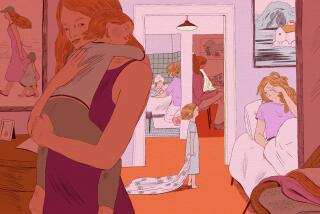They’re not hoarders, they’re just messy
If mental health problems come in and out of fashion, we must be in the midst of a hoarding heyday. With not one but two TV series and at least 10 books on the topic published in the last two years, hoarding has spawned a cottage industry cluttered with all manner of experts, fully credentialed and entirely self-appointed.
For parents, however, one question has remained largely unaddressed: Is my kid a hoarder?
Is living with a dizzying number of possessions — the mountain of Legos, the unclaimed Barbie limbs, the drum sets, the Blabla dolls, the Harry Potter paraphernalia — simply part of parenting in a stuff-addicted culture? Or can the de rigueur party grab bags, Happy Meal freebies and other stuff that adults might see as trash all add up to more than any kid — or parent — can handle?
Joshua Rose and partner Rafael Kalichstein were pretty near convinced their daughter had a hoarding problem. According to Rose, 6-year-old Skylar is a voracious collector of “random gypsy garbage.”
“She’ll go on excavation hunts at school, looking for what most would be junk but for her are treasures,” he said.
Broken rings, tattered twigs and hundreds of tiny pieces of paper can be found in her backpack at any given time, Rose said. “And brochures,” Kalichstein added. “She’s obsessed with brochures and will take any one as long as it’s got pictures and it’s free. She’s got tons of ski brochures.”
But for Randy O. Frost, co-author of “Stuff: Compulsive Hoarding and the Meaning of Things” and a professor of psychology at Smith College in Massachusetts, Skylar’s behavior bears classic signs of being a kid, not a hoarder.
“Collecting is very important for kids, starting at about age 2, when they learn the meaning of the word ‘mine,’ up until early teenage years, which is why most kids have very cluttered rooms,” Frost said. “And that shouldn’t be of concern.”
Eric Storch, associate professor of clinical psychology at the University of South Florida, seconds that notion.
“It’s perfectly ordinary for kids to have collections, even extensive ones,” said Storch, who used his own 2-year-old daughter as an example. “She has these Beanie Baby-type animals that she loves,” he said, and will she eventually shed them and streamline her possessions? Not necessarily.
“There are so many kids who never achieve order, and they’re still normal,” he said. “A messy room isn’t hoarding. It’s just a messy room.”
Like the kind that Shana Shea d’Alton lives with. The mother of two said daughter Astrid, 8, has the most chaotic space in their 1,700-square-foot Ventura house.
“She’s my collector of the unessential,” D’Alton said. “If we go for a walk, we’re coming back with feathers, rocks, butterfly carcasses. She can find the treasure in anything.”
To an adult, the bedroom may look like your basic kid disaster, but D’Alton said to her daughter, it’s a high altar to her current obsessions, which right now are miniature Japanese erasers and heart-shaped rocks. If there is a silver lining to the messy room, D’Alton found it: When the home recently was burglarized, Astrid’s space was untouched.
“They took our XBox, video camera, our Wii from the family room,” D’Alton said. “But the police said that they didn’t enter her room. The mess must have terrified them.”
To deal with her daughter’s room, D’Alton routinely declutters it — without telling Astrid.
“Every six weeks to two months, I’ll go through and clear stuff out,” she said. “Have I ever gotten caught? I’m sure I have, but it’s never been a huge moment for her.”
That lack of a “huge moment” is a key difference between potential hoarders and run-of-the-mill collectors, Frost and Storch said.
“The kid who has trouble decluttering a room, when throwing something away can become an ordeal, when you’re getting to the point of a panic attack or a full-blown tantrum,” Storch said, “that’s when you see this as being more abnormal.”
Frost said the key isn’t the amount of stuff but the relationship to stuff.
“With kids who truly do have a hoarding complex, their anthropomorphizing of objects is intense,” he said. Example? “One kid we saw spilled Kool-Aid on the sidewalk and was upset because the Kool-Aid was being hurt.”
Parents may wonder: To a certain extent, don’t a fair number of children become so attached to belongings that they form emotional attachments to stuff, as though the stuff were human? Don’t many kids (and adults, for that matter) lose it when their belongings are thrown out without consent?
Yes, Frost said. But it’s a matter of degree. If throwing out belongings shifts from meltdown to a full-blown panic attack, the problem very well may be defined as hoarding, which is a form of obsessive-compulsive disorder. Parents are then advised to consult with a psychologist or pediatrician or refer to the International OCD Foundation’s website (https://www.ocfoundation.org), which includes a section on OCD in children.
Not that Cynthia Omololu ever worried that her son’s attachment to stuffed animals qualified as hoarding.
“I knew that wasn’t the case, even if he is really attached to them,” Omololu said of the collection that numbers more than 100. Instead of simply throwing the stuffies out, Omololu, author of “Dirty Little Secrets,” a fictional account of growing up with a hoarding mother, decided to enlist her 10-year-old son in the process. “We talked about it, and on his own he ended up getting rid of about 25 animals. But I couldn’t throw them away; they had to go to a shelter. For him to visualize them in the trash was way too sad.”
Kalichstein and Rose took a slightly different approach to dealing with Skylar’s stuff. After consulting with her teachers and other parents, “we calmed down about the whole thing and realized that collecting is part of being a kid,” Kalichstein said, “even if we don’t always understand why she’s collecting certain things.” But given that the two are also interior designers, hired to create sleek, clutter-less spaces, they felt compelled to limit the number of objects entering their less-than-1,000-square-foot Los Angeles home. The couple created a storage system that allows their daughter to take part in decisions.
“We’ve got a set of decorative luggage that we put in her room,” Kalichstein said. “The largest holds her collection of blankets, the middle has her dress-up clothes and the last, which is still pretty big, is for anything she wants to put in there. We won’t edit it.”
Once the trunks are full, that’s it.
“It gives her a boundary which says, ‘This is the limit to which I can collect,’” Kalichstein said. “I think it gives her a sense of ownership, of being a big girl.”
Most important, Rose said, once they stopped worrying about putting a label on the behavior, they have been able to enjoy it, to a point.
“Whether it’s the enormous amount of Silly Bandz or just the stuff she finds outside, I’ve realized that she creates stories for everything she finds; they’ve got a purpose for her,” Rose said. He wants his daughter to enjoy that, but he also wants to enjoy the house. So Skylar can go crazy at the dining table and in her room, but other areas are kept the way the adults like them. “It’s the same thing I tell my clients,” Rose said. “There should be space for both your kids and you in the house. You don’t want to wait until they leave for college to start enjoying your home.”


